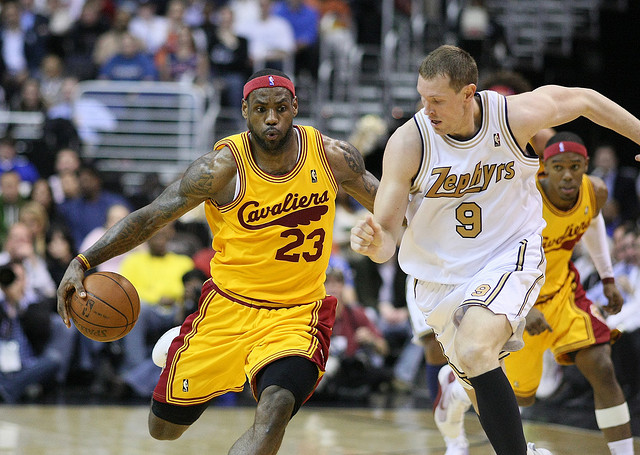By Anusha Rasalingam
With one 2010 decision, LeBron James chose the certainty of winning championships, but lost the love of his hometown fans and the respect of many others who follow the NBA. The decision he made on Friday, however, reveals that, having won his rings, LeBron now wants to be loved.
Cynics may note that, even with every advantage in place, King James ended up losing half of the finals he was in while in Miami. They may add that, as he approaches 30, his chance of winning as many championships as Jordan, Magic or Russell were rapidly dwindling, and that this return of the prodigal son was a deft way of lowering expectations and changing the metrics by which his career and legacy would be measured.
But, aside from the decreased presence of Andy Murray and Serena Williams courtside in Miami, what does The Second Decision have to do with tennis? It’s true that top tennis players these days don’t have to deal with teams, free agency, or deciding where to take their talents. However, they are not immune to the basic human desire that Lebron showed the world on Friday: they want to be loved.
One of the most enduring legacies of the Federer-Nadal era of tennis is the abundant love that fans have for these players. There are many reasons – first and foremost, of course, are the players themselves, but increased access to the players and the abiility to watch more tournaments online has helped feed the flames of fandom as well.
Roger Federer’s fans adored him from the start, as if struck by a thunderbolt when he won his first Wimbledon trophy, and have remained besotted with him and his game ever since. Rafael Nadal enjoys an equally robust, if not quite as broadly based, love from his fans, who enjoyed watching him grow from youthful warrior to all-time great over the past decade.
During the Big Four era, the love has not been equally divided. Fedal still consumes most of the fans’ devotion, but both Andy Murray and Novak Djokovic have made inroads into the fans’ hearts. With his loss in the 2012 Wimbledon final and tearful interview afterwards, Andy Murray inspired more fan devotion than he had in years of success on the tour. Winning Wimbledon the next year assured him of likely knighthood in the future, but also of eternal affection from British fans for being the first Brit to win the Wimbledon men’s singles titles in 77 years.
Novak Djokovic is easily the most naturally outgoing of the Big Four, but often lags behind the others in fan support – much to his chagrin. Frequently cast as Jan Brady to Fedal’s Marcia, one can practically hear him say “Marcia, Marcia, Marcia” when faced with the cheers for his more popular rivals. It hardly seems fair – Djokovic speaks even more languages than Federer and fights as hard as Nadal, yet often finds himself daring crowds to love him as he defeats his more popular rivals. However, against the rest of the field, and especially in Serbia, Novak enjoys significant fan support, which should only increase as time goes on.
By contrast, during the Cold War, it was not uncommon for top tennis players to be the objects of scorn – sometimes due to politics, and sometimes due to personality.
Indeed, Ivan Lendl, while at the peak of his powers, made the cover of Sports Illustrated – but the story was entitled “The Champion That Nobody Cares About.” Partly because he, a Czech player, rose by taking down American champions McEnroe and Connors, and partly because the world was not quite ready for his brand of humor, Lendl often faced crowds rooting against him.
If he had achieved the same success today, one has to believe that his nationality would not work against him, and his snarky zingers – he once famously referred to a young Andre Agassi as “a haircut and a forehand”– would have gotten him a serious Twitter following.
During the same era, Martina Navratilova faced similar fan opposition – frequently because she was competing against American sweethearts Tracy Austin and Chris Evert, but also because of her Czech background and her sexual orientation. Over time, Martina won the crowds over, and was embraced as a popular veteran on the court and respected as an intelligent and thoughtful activist and commentator off it. And, of course, John McEnroe and Jimmy Connors inspired both love and hate for their passion and on court antics.
In this era, thankfully, it’s hard to find a villain on a tennis court – and certainly not one in need of redemption in the way that LeBron was. It is one of the true pleasures of this era to witness great play by players who inspire both on and off the court, and whose decisions, big and small, have brought them closer to the fans rather than alienating them.
As this era closes, and we nervously anticipate the exit of these great players, it’s easy to wonder if the game will ever be this compelling again. But, the most beloved player of this era, Roger Federer, isn’t worried. Acknowledging the fan support he received at this year’s Wimbledon, he took the long view:
“I know they love tennis. They’ll love tennis after we’re all gone.”





Great article!! Love Fedal-marcia 4 EVA!!